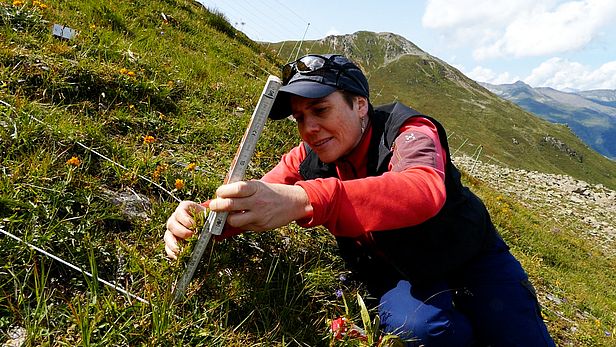At Stillberg near Davos, the SLF is investigating whether spruce and larch seedlings can establish above the current forest line.
"Climate change is turning plants into mountaineers." "The rock ptarmigan scales new heights." Headlines like these now feature regularly in the media, a reflection of the fact that, as temperatures rise, many plants and birds are now found at higher elevations than was the case just a few decades ago. As part of the international G-TREE experiment, researchers worldwide are investigating whether the forest line too is shifting as a result of climate change. One of these scientists is Esther Frei, who works at the Climate Change, Extremes and Natural Hazards in Alpine Regions Research Centre (CERC), part of the WSL Institute for Snow and Avalanche Research (SLF). She says: "Forest lines are among the most important and striking transitions between vegetation types worldwide. If these lines change, this can also affect forests' protective function or animal and plant habitats, for example."
Stillberg: a tried-and-tested outdoor laboratory ¶
Here in Switzerland, the forest line has been rising since the end of the 19th century, mainly because mountain forest, once pushed back in order to free up land for agriculture, is now reclaiming territory as use of the alps declines. What the researchers want to know now is whether trees today can gain a foothold at higher elevations than they did in the past. The research in Davos is being carried out at Stillberg in the Dischma Valley, where for decades the SLF has been successfully studying how trees at the forest line respond to different environmental influences. There, back in 2013, Frei established 20 test sites at the current forest line (2,100 m above sea level), another 20 at 1,930 m and the same number at 2,410 m. She then exposed the sites to different treatments. For example, she removed the natural vegetation from some of the sites and in others sowed a set number of spruce or larch seeds. Every year since then, she has been monitoring which of the sites are seeing tree seeds germinate and how the seedlings develop.
Germination possible above the forest line ¶
The first few years of surveying have revealed that tree seeds can germinate even well above the current forest line. In fact, to start with, it was the highest site that saw the largest number of seedlings sprout, although only where seeds had previously been sown on the test plots concerned. In general, both spruce and larch germinated better when no other plants were competing for their space. However, after just two years, the proportion of surviving seedlings above the forest line was significantly smaller than further down, suggesting that the harsh winters were taking their toll on the seedlings.
These results tally with those of the other G-TREE sites in Europe, North America, Australia and New Zealand. But what does this mean for the future forest line? "First of all, tree seeds have to reach higher locations and be able to germinate there without competition," says Frei. "However, the forest line will only rise where the location and management allow the seedlings to grow into trees." The experiment has now been running for eight years, and a few seedlings still survive at 2,410 m above sea level, i.e. around 300 metres above the current forest line. Remarkably, they are actually growing faster than those lower down. Over the coming years, the experiment will show whether the seedlings survive in the long term and so – together with other studies at Stillberg – will contribute to a better understanding of tree survival at the forest line.
This article first appeared in a slightly abridged form in the Davoser Zeitung on 31 May 2022.
Links ¶
- G-TREE project page
- Stillberg afforestation research
Contact ¶
Copyright ¶
WSL and SLF provide the artwork for imaging of press articles relating to this media release for free. Transferring and saving the images in image databases and saving of images by third parties is not allowed.
